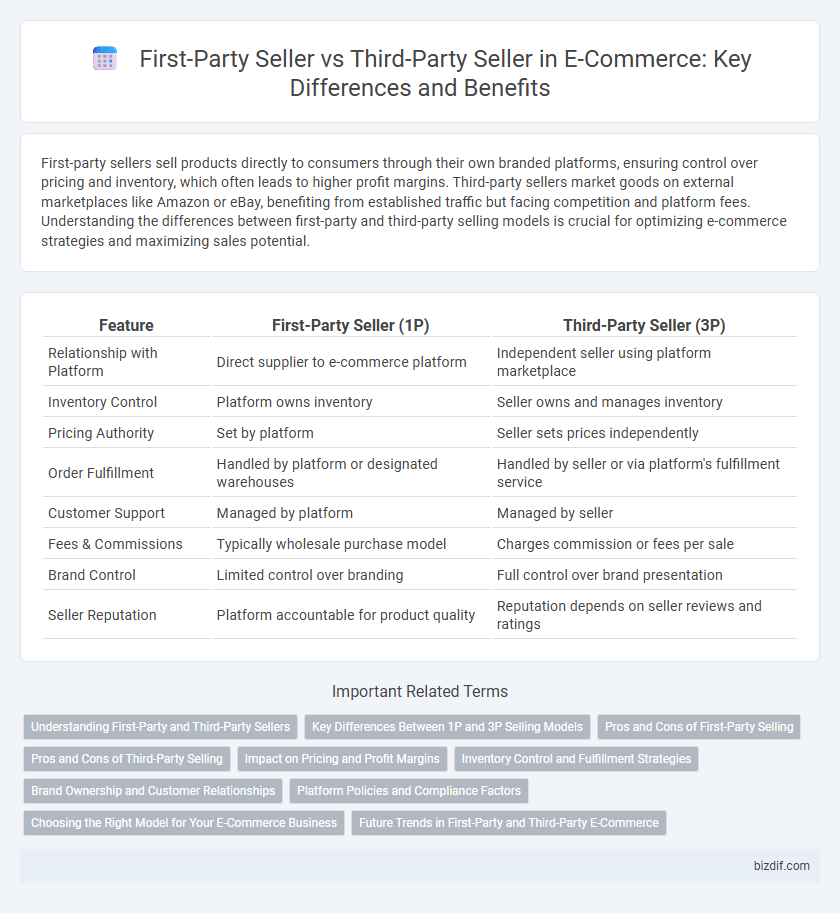First-party sellers sell products directly to consumers through their own branded platforms, ensuring control over pricing and inventory, which often leads to higher profit margins. Third-party sellers market goods on external marketplaces like Amazon or eBay, benefiting from established traffic but facing competition and platform fees. Understanding the differences between first-party and third-party selling models is crucial for optimizing e-commerce strategies and maximizing sales potential.
Table of Comparison
| Feature | First-Party Seller (1P) | Third-Party Seller (3P) |
|---|---|---|
| Relationship with Platform | Direct supplier to e-commerce platform | Independent seller using platform marketplace |
| Inventory Control | Platform owns inventory | Seller owns and manages inventory |
| Pricing Authority | Set by platform | Seller sets prices independently |
| Order Fulfillment | Handled by platform or designated warehouses | Handled by seller or via platform's fulfillment service |
| Customer Support | Managed by platform | Managed by seller |
| Fees & Commissions | Typically wholesale purchase model | Charges commission or fees per sale |
| Brand Control | Limited control over branding | Full control over brand presentation |
| Seller Reputation | Platform accountable for product quality | Reputation depends on seller reviews and ratings |
Understanding First-Party and Third-Party Sellers
First-party sellers are businesses that sell their own products directly through their e-commerce platform, maintaining full control over inventory, pricing, and customer experience. Third-party sellers operate through a marketplace, leveraging the platform's infrastructure to reach customers but handling their own inventory, pricing, and fulfillment responsibilities. Understanding the distinctions between first-party and third-party sellers helps businesses optimize their sales strategy and align with their operational capabilities.
Key Differences Between 1P and 3P Selling Models
First-party (1P) sellers sell products directly to the e-commerce platform, which then controls pricing, inventory, and fulfillment, whereas third-party (3P) sellers list their products on the platform while managing their own inventory and customer service. The 1P model offers greater brand control and guaranteed sales through wholesale agreements, while 3P sellers benefit from higher profit margins and flexibility in pricing strategy. Inventory management, shipping methods, and customer interaction vary significantly between 1P and 3P models, impacting operational responsibilities and revenue distribution.
Pros and Cons of First-Party Selling
First-party selling in e-commerce offers direct control over pricing, branding, and customer experience, fostering stronger trust and loyalty. It ensures consistent product quality and faster fulfillment but requires significant investment in inventory management and marketing. Limited scalability and higher operational costs can pose challenges compared to third-party seller models.
Pros and Cons of Third-Party Selling
Third-party sellers gain access to established e-commerce platforms with vast customer bases, enabling rapid market entry and reduced upfront costs. However, they face increased competition, platform fees, and limited control over customer data and branding, potentially impacting profit margins and long-term growth. Reliance on platform policies and potential marketplace restrictions can also pose challenges for scalability and operational flexibility.
Impact on Pricing and Profit Margins
First-party sellers, who sell directly to consumers through the e-commerce platform, typically benefit from controlled pricing strategies and higher profit margins due to reduced competition and platform fees. In contrast, third-party sellers face dynamic pricing pressures from marketplace competition and often incur additional fees, which can compress profit margins. The difference in pricing autonomy directly influences overall profitability and pricing flexibility within the e-commerce ecosystem.
Inventory Control and Fulfillment Strategies
First-party sellers maintain direct inventory control, managing stock levels and fulfillment through the e-commerce platform itself, which ensures consistent quality and faster order processing. Third-party sellers rely on external inventory systems and may use marketplace fulfillment services, leading to varied delivery speeds and less centralized stock management. Effective fulfillment strategies for first-party sellers often include integrated warehouses, while third-party sellers focus on flexible outsourcing and multiple distribution channels to meet demand.
Brand Ownership and Customer Relationships
First-party sellers maintain direct brand ownership, allowing complete control over product presentation and pricing on e-commerce platforms, which enhances brand authenticity and trust. They engage directly with customers, fostering stronger relationships through personalized marketing, customer service, and data insights. Third-party sellers operate independently, often limiting their influence over brand image and customer interaction, as the marketplace controls much of the buying experience and data access.
Platform Policies and Compliance Factors
First-party sellers operate directly under the e-commerce platform's policies, ensuring seamless compliance with inventory, pricing, and fulfillment standards mandated by the platform. Third-party sellers must adhere to the platform's marketplace rules, including stricter scrutiny on product authenticity, intellectual property rights, and data privacy regulations. Non-compliance risks suspension or removal, making thorough understanding of platform-specific policies critical for both seller types to maintain operational status and buyer trust.
Choosing the Right Model for Your E-Commerce Business
Choosing between a first-party seller model, where businesses sell directly to consumers through their own platforms, and a third-party seller model, which leverages marketplaces like Amazon or eBay, depends on factors such as control over branding, profit margins, and logistics management. First-party sellers benefit from higher brand control and customer data access but bear the full responsibility of inventory and fulfillment, while third-party sellers gain exposure to larger audiences and reduced operational burdens at the cost of lower margins and less direct customer interaction. Evaluating your e-commerce business goals, resources, and scalability needs helps optimize the choice, ensuring sustainable growth and competitive advantage.
Future Trends in First-Party and Third-Party E-Commerce
Future trends in first-party e-commerce highlight increased direct-to-consumer engagement, leveraging proprietary customer data to personalize shopping experiences and enhance brand loyalty. Third-party sellers are expected to capitalize on expanding marketplace platforms, using AI-driven analytics and dynamic pricing strategies to optimize inventory and meet diverse consumer demands. Both models will increasingly integrate advanced technologies like augmented reality and blockchain to improve transparency, streamline operations, and foster trust in online transactions.
First-Party Seller vs Third-Party Seller Infographic

 bizdif.com
bizdif.com